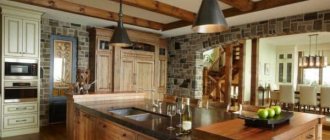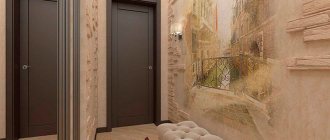Decorative stone: comfort and order in the house
Why is decorative stone most often used when decorating a hallway? It's simple. This room accumulates the largest amount of dust and dirt brought into the house from the street. Therefore, cleaning is carried out here much more often than in other rooms. Artificial stone, which has excellent antibacterial and dirt-repellent properties, is not afraid of either water or detergents. Therefore, cleaning the hallway with such finishing is easy and without the risk of spoiling it.
Decorative stone in the interior of the hallway in the photo
The technology for manufacturing decorative stone allows you to create elements of a wide variety of colors, textures and even shapes. It is easy to process and, thanks to its light weight and resistance to mechanical damage and household chemicals, ensures reliability and durability of the finish. But the main thing about this material is its versatility. It can be combined with any other type of decor, from wall wallpaper to gypsum stucco or ceramic tiles.
Combination of decorative stone and textured wallpaper in the hallway
If you decide to use decorative stone in the interior of the hallway, know that a fragmented finish will look most expressive here:
- window and door openings;
Doorways trimmed with decorative stone
- viewed angles;
Decor of the outer corner in the hallway
- areas around decorative elements of furnishings or pieces of furniture;
Framing a wardrobe with decorative stone
- depressions and niches;
Decorating a niche in the hallway
- contact areas (the section of walls above the baseboard and any other places where contact with shoes is possible and there is a risk of severe contamination);
Decor of the contact area in the hallway
- areas designated for storing shoes, clothing and household items.
Decorating the hanging area in the hallway
Artificial stone fits perfectly on surfaces, incl. embossed, from any material, be it concrete, brick or even wood. The only condition is that the base should be carefully prepared for finishing, achieving maximum adhesion rates.
Ideas for artificial stone in hallway decor
Despite the fact that stone is considered a very characteristic material, designers recommend adding some touches. In particular, it is proposed to highlight the outline with darker paint, this will give the masonry additional volume. Spotlights that highlight the texture of the stone are combined very effectively with stone cladding. It is also possible to include mirrors and green plants to create a complete picture of the design in the hallway.
For artificial stone, light plays an important role.
Drawn plants can be used as additional decoration
Combines very well with artificial stone with green plants
Greenery and stone can be combined in this way.
Spotlights successfully highlight the artificial stone in the hallway interior
It is very important to choose the right light in the interior of a hallway decorated with artificial stone.
The play of light and shadow is extremely important when decorating a hallway with artificial stone. Did you like the article? Share on social networks!
Types of artificial stone and features of its use
When choosing artificial stone for finishing the hallway, it is important to decide on the color, shape and texture. For example, light-colored material contributes to the visual expansion of space, while dark colors add richness to the interior. Therefore, it is best to use decorative stone in spacious rooms, and even then without getting too carried away, since even a spacious and well-lit hallway can turn into a gloomy and cold stone bag.
Options for arranging lighting in a hallway with a stone finish in the photo
Depending on the manufacturing technology, there are several types of decorative stone:
- rubble (analogous to boulders or pebbles);
Rubble decorative stone
- chipped (imitates unprocessed rock);
Chip decorative stone
- sawn (with an unpolished front surface and clear geometry);
Sawn decorative stone
- mosaic (with elements adjusted to a specific color or geometric composition);
Mosaic decorative stone
- brick (imitates various types of brickwork);
Decorative stone to look like white brick
- tiled (with a polished front surface imitating natural polished stone - marble, granite, etc.);
Tiled decorative stone
- fantasy (has a complex texture and color not found in nature).
Decorative stone decoration in fantasy style
You shouldn’t get carried away with combinations of different types of artificial stone in the interior, and especially in the often small and cramped hallway. You run the risk of making the atmosphere too colorful, putting pressure on the consciousness of your household and guests. Within one room, a combination of a maximum of two varieties of stone decor, or rather its fragments, is sufficient. The best option is to use materials of the same type, but with slightly different texture and shade. This will allow you to add variety to the environment without allowing it to become overly rich.
When selecting artificial stone for the hallway, it is extremely necessary to take into account the lighting features - it should be harmoniously combined with the colors of the decor and emphasize the advantages of the environment.
Decorating the hallway with decorative stone and wallpaper
If you have the means and desire to have a piece of nature in your apartment, then finishing with decorative stone is suitable for you. There are two types of artificial stones: gypsum and artificial concrete. Gypsum stone is much easier to work with; you can easily cut it into the shape you need. It will be much heavier with artificial concrete stone, but it is almost half the price: and for some people, price is the main factor in choosing the right material.
Depending on your preferences regarding decorative stone, you can choose gypsum or artificial concrete
This finish also has its disadvantages: practically, the same disadvantages as natural stone:
- Decorating with decorative stone cannot be called cheap: it is also very expensive.
- Artificial stone is very cold: many people don’t really like it.
- Some artificial stones do not like high temperatures: it is important to choose a stone based on its future purpose, room and other factors.
Hallway: elegance and style in the interior
The first thing you should pay attention to when choosing stone decor for the hallway is its color mood. The latter is most directly related to the quality, intensity and direction of natural light. So, in the case of a narrow and cramped hallway, dark shades are suitable - here the light, warm colors of limestone, tuff and sandstone will look much more pleasant.
Decorative stone in light colors for a cramped hallway
Using stone as the main material for finishing a given room, even if it is quite spacious and well lit, is worth it only if such a solution corresponds to the overall design of the apartment. And for the price, renovations in the hallway with decorative stone trim will literally be golden for you, so it would be much more rational to use it to create accents on individual features of the decor.
Accents in the hallway setting
Framing doorways or highlighting various elements of the interior or layout can be laid out either chaotically or created with the help of fragments of material, geometric patterns and color transitions. By the way, if you have a large mirror in your hallway, be sure to frame it - this will give the interior a touch of aristocracy and style.
Decorating a mirror in the hallway
Try to avoid frontal lighting of a section of wall with such decor - it will negate all the beauty of the decoration relief.
Remember that when decorating the hallway with decorative stone, it is better to abandon the chandelier and install several small built-in lamps on the ceiling and walls, distributing the lighting more evenly. At the same time, if a textured, small stone in the hallway will look good on the active areas of the design composition, then a coarse-grained material is much better suited for finishing the area around the fireplace, window or doorways.
Original hallway lighting with stone decor
Hallway design with stone
Decorative stone can be used in the hallway in combination with other facing materials, as the main background and as bright accents.
A fragmentary “ragged” arrangement of stones is often used:
- around arches and doorways;
- the perimeter of one or more walls;
- corner spaces.
Select a part of the wall as a background for decorative elements, furniture, special areas:
- paintings, collages, vases;
- mirrors, lamp;
- indoor plant;
- armchairs, wardrobe, chest of drawers;
- hangers, shoe racks.
In addition, niches, the lower perimeter of the room, load-bearing beams and columns are emphasized. One of the walls can be completely selected
Artificial stones imitate :
- unprocessed, chipped rock;
- sawn unpolished cobblestones;
- rubble smooth boulders of various sizes;
- mosaic;
- varieties and analogues that do not exist in nature.
Attention! It is recommended to choose no more than two types of rocks for one space.
Following simple rules will help create an elegant look at home. Decorating a hallway with decorative stone and wallpaper is a fascinating and creative process; photos of interesting options are presented below.
How to work with decorative stone?
If you have already decided on the interior design, it’s time to prepare for work. First of all, it is necessary to remove the old finish - peeling plaster, wallpaper, facing tiles, etc. If the walls in the hallway have unevenness with differences of more than 3-5 cm or pronounced defects, they will have to be eliminated, that is, the surface should be leveled by plastering.
Rough finishing of the hallway
The next step is marking. On the walls prepared for finishing, you need to mark the boundaries of the zones that you are going to decorate with stone. In this case, it is necessary to take into account the size of the skirting boards and cornices. Next, in one of the corners of the room you need to make a control mark, and then transfer it to other corners and other areas for decoration.
Marking walls for decorative stone
Before laying decorative stone, you should prime the walls and check the quality of adhesion. To do this, the treated areas are moistened with water. Where it has not been absorbed into the rough plaster, re-priming is required. Make sure that no dirt remains on the walls - they reduce the quality of adhesion of the decor to the base.
The back surface of the stone must be cleaned of dust and moistened before laying. A special glue is applied to it, which must be prepared first. After this, the fragment is installed on the wall with mandatory level control. At the end of the work, the decor should be allowed to dry and you can proceed to the last stage - rubbing the seams.
Laying decorative stone
Regardless of the grain size and color vector of the decor, installation begins from the bottom of the corner. Particular attention must be paid to corner elements - not only the appearance, but also the practicality and even safety of the finish depends on the reliability of their installation. After all, you can accidentally injure yourself with sharp teeth on the outer corners, and dirt and dust will always accumulate in the cracks between poorly fitted corner fragments.
Stone-like wallpaper in the hallway
In addition to modern wallpapers, which have not only the appearance of stone, but also its texture, there are also classic wallpapers depicting this natural element. Such materials are cheap, so they are used most often. There are different types of wallpaper with a print reminiscent of natural stone. They have different characteristics and, accordingly, different prices. Some of them look very realistic, while others immediately reveal their unnatural origin.
Types of stone wallpaper:
- Paper wallpaper with a stone look is not the most suitable option for a hallway; they have low performance characteristics and a short service life. Since the walls in the hallway are most susceptible to contamination, you will have to change such wallpaper every two years.
- Vinyl wallpaper perfectly conveys the texture of stone. They have a coating that looks very realistic. This is a wear-resistant and high-quality material.
- Non-woven stone-look wallpaper can be painted; it resists moisture well and does not deform when repainted. This option is suitable for those who want to create a unique and inimitable interior.
- Photo wallpaper conveys the depth and originality of the stonework. They look incredibly realistic and may have additional decorative elements.
Among the advantages of stone wallpaper, it is worth noting excellent aesthetic qualities and low price
If you are decorating a living room or bedroom with stone wallpaper, it is better to highlight only one wall with a complex and characteristic pattern, but in the hallway, such material is suitable for decorating the entire space.
Stonework will give the room a medieval chic. Anyone who enters the hallway decorated with such material will feel like a guest of a medieval castle.
When choosing wallpaper with stonework for your apartment, remember that such an element sets the tone for the entire interior, so the furniture must match. In combination with stone, forged hangers and wooden banquettes-chests look best. You can also choose a more modern content, but then it should be executed in calm light or dark colors.
Related article: How to determine the quality of interior doors?
Stone finishing: practical subtleties
It will be much easier to choose lighting for a hallway with stone decor if you alternate areas lined with stone with smooth light walls covered with plain wallpaper, plaster or paint. Various elements or areas of the interior with a dominant stone finish can be additionally illuminated using sconces, LED strips or group wall lamps.
Combination of decorative stone and wallpaper in the interior of the hallway
It is recommended to lay stone on the walls with some space between the fragments, which, similar to ceramic tiles, is filled with a special grout. The color of the latter can be updated or changed over time, which will significantly refresh the atmosphere. To match the stone finish to the color or geometric shape, the material is laid on the floor. In this case, it is necessary to ensure the absence of sharp changes in shade and relief.
Grouting decorative seams for brickwork
Decorative stone in the hallway will be less susceptible to contamination and will last much longer if treated with acrylic varnish. The latter is applied using an airbrush or spray gun. Laying of finishing fragments is carried out offset, like brickwork.
Lacquered decorative stone
Decorative stone goes well with suspended ceilings, gypsum-cement plaster or thick wallpaper. At the same time, the combination of such decor with ceramic tiles is more presentable and practical to maintain.
The choice of decorative stone and hallway decoration option entirely depends on your financial capabilities and taste. By adhering to the basic principles of design and observing the technology of laying and finishing stone decor, you will be able to create the interior of your dreams independently and with minimal effort and money.











